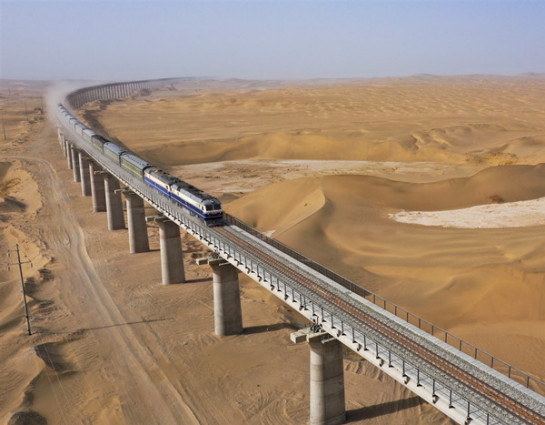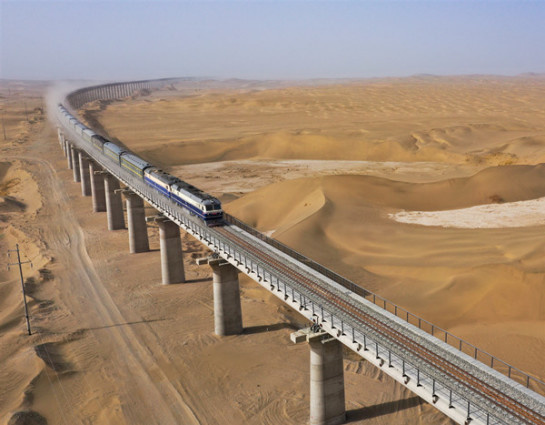By Jiang Yunlong, Li Ya'nan, People's Daily

A train runs on the Hotan-Ruoqiang rail line in northwest China's Xinjiang Uygur autonomous region. (Photo by Wen Xinghua)
There's a 2,712km railway in northwest China's Xinjiang Uygur autonomous region. It crosses desert, the Gobi, and no man's land and stretches in scorching heat, sand storms and extreme coldness. It connects multiple places in five prefectures in southern Xinjiang and serves millions of people of various ethnic groups. Because of it, many remote cities have had access to railway services for the first time.
It is the rail loop line that encircles the Taklamakan, China's largest desert. As the world's first desert rail loop line, the railway was completed after the new Hotan-Ruoqiang rail line was linked with the Ruoqiang-Korla section of the Golmud-Korla railway line, and the Korla-Kashgar and Kashgar-Hotan sections of the southern Xinjiang rail line in June last year.
"It was totally impossible to get cargos to Tibet in three days," said Huang Wei, general manager of a coal mining company in Xinjiang, adding that it took over 10 days before the Golmud-Korla railway line was put into service.
Now, the loop line has further facilitated transportation, which helps broaden the sales channel of his products, the man added.
The Golmud-Korla railway line is an important part of the loop line encircling the Taklamakan. It handles over 95 percent of the cargos in southern Xinjiang. From a line that connects Qinghai province and Tibet autonomous region, it has grown into a logistics artery that links Gansu, Sichuan and Yunnan provinces and contributes to the economic development of west China.
Today, carpets from Hotan, plums from Kashgar and apples from Aksu are being sent to various parts of China with a much faster speed.
According to statistics, since the loop line was put into operation, freight transport centers in Korla and Kashgar has shipped nearly 33.5 million tons of cargos.
The loop line has for the first time brought railway services to Lop, Qira, Yutian, Minfeng, Qiemo and other places in southern Xinjiang, facilitating local residents of various ethnic groups.
It is learned that the Hotan-Ruoqiang rail line has witnessed more than 360,000 passenger trips in the past year, and trains were kept full almost every day.
At around 1:00 pm, Train 5818 was about to depart from Hotan. Attendant Mihray Mesawur retracted a bridge plate after receiving the order of departure and closed the door of a car. As the train blew its whistle, buildings outside the window started moving backwards and were gradually replaced by desert.
Mihray Mesawur was born in Qira county, Hotan. Before the Hotan-Ruoqiang rail line was put into operation, the county had no access to railway.
The woman said that she had to spend 2 hours on bus and then take the train to go to work in Urumqi, the capital of Xinjiang.
"Now I can go to the city by taking Train 5818," she noted.
Tursuntohti Aminniyaz told People's Daily that it was the first time for him to take a train. "I'm going to Urumqi first and then Savan county. I have relatives there who told me I could probably get a decent job there," he said.
When the train passed Yutian, it was all desert outside the windows. However, there were grass grids and a green corridor about tens of meters wide along the tracks. According to a railway worker, the greenery was designed to protect the railway from sandstorms.
The grass grids cover an area of 50 million square meters along the Hotan-Ruoqiang rail line, which is also lined with 7,600 hectares of artificial trees. This effectively protects the railway and improves the ecology on both sides of the railway.
Train 5818 arrived at the Minfeng railway station at 4:58 pm. About 186km of the 264km section north from the station was located in desert. That's why passengers always feel there are fine sands in their mouths.
The number of days with sandstorms exceeds 200 each year there, said Zhong Dingjun, a chief engineer in Kashgar, adding that the high roadbeds, long and high bridges, as well as high tunnels were all built to make way for sand in case it buries the tracks.
Apart from manual inspection, big data technology is also applied to ensure the stable operation of the desert rail loop line. For example, with the help of track geometry cars, as well as vehicle-mounted circuit checkers that collects gauge width and height, targeted maintenance can be carried out.
"They can find out a variation as small as 5mm in track height," said Zhong.
The desert rail loop line is injecting vitality into the economic and social development in southern Xinjiang, carrying the aspiration of the people along its route for a better life.
It is the rail loop line that encircles the Taklamakan, China's largest desert. As the world's first desert rail loop line, the railway was completed after the new Hotan-Ruoqiang rail line was linked with the Ruoqiang-Korla section of the Golmud-Korla railway line, and the Korla-Kashgar and Kashgar-Hotan sections of the southern Xinjiang rail line in June last year.
"It was totally impossible to get cargos to Tibet in three days," said Huang Wei, general manager of a coal mining company in Xinjiang, adding that it took over 10 days before the Golmud-Korla railway line was put into service.
Now, the loop line has further facilitated transportation, which helps broaden the sales channel of his products, the man added.
The Golmud-Korla railway line is an important part of the loop line encircling the Taklamakan. It handles over 95 percent of the cargos in southern Xinjiang. From a line that connects Qinghai province and Tibet autonomous region, it has grown into a logistics artery that links Gansu, Sichuan and Yunnan provinces and contributes to the economic development of west China.
Today, carpets from Hotan, plums from Kashgar and apples from Aksu are being sent to various parts of China with a much faster speed.
According to statistics, since the loop line was put into operation, freight transport centers in Korla and Kashgar has shipped nearly 33.5 million tons of cargos.
The loop line has for the first time brought railway services to Lop, Qira, Yutian, Minfeng, Qiemo and other places in southern Xinjiang, facilitating local residents of various ethnic groups.
It is learned that the Hotan-Ruoqiang rail line has witnessed more than 360,000 passenger trips in the past year, and trains were kept full almost every day.
At around 1:00 pm, Train 5818 was about to depart from Hotan. Attendant Mihray Mesawur retracted a bridge plate after receiving the order of departure and closed the door of a car. As the train blew its whistle, buildings outside the window started moving backwards and were gradually replaced by desert.
Mihray Mesawur was born in Qira county, Hotan. Before the Hotan-Ruoqiang rail line was put into operation, the county had no access to railway.
The woman said that she had to spend 2 hours on bus and then take the train to go to work in Urumqi, the capital of Xinjiang.
"Now I can go to the city by taking Train 5818," she noted.
Tursuntohti Aminniyaz told People's Daily that it was the first time for him to take a train. "I'm going to Urumqi first and then Savan county. I have relatives there who told me I could probably get a decent job there," he said.
When the train passed Yutian, it was all desert outside the windows. However, there were grass grids and a green corridor about tens of meters wide along the tracks. According to a railway worker, the greenery was designed to protect the railway from sandstorms.
The grass grids cover an area of 50 million square meters along the Hotan-Ruoqiang rail line, which is also lined with 7,600 hectares of artificial trees. This effectively protects the railway and improves the ecology on both sides of the railway.
Train 5818 arrived at the Minfeng railway station at 4:58 pm. About 186km of the 264km section north from the station was located in desert. That's why passengers always feel there are fine sands in their mouths.
The number of days with sandstorms exceeds 200 each year there, said Zhong Dingjun, a chief engineer in Kashgar, adding that the high roadbeds, long and high bridges, as well as high tunnels were all built to make way for sand in case it buries the tracks.
Apart from manual inspection, big data technology is also applied to ensure the stable operation of the desert rail loop line. For example, with the help of track geometry cars, as well as vehicle-mounted circuit checkers that collects gauge width and height, targeted maintenance can be carried out.
"They can find out a variation as small as 5mm in track height," said Zhong.
The desert rail loop line is injecting vitality into the economic and social development in southern Xinjiang, carrying the aspiration of the people along its route for a better life.
 Menu
Menu
 World's first desert rail loop injects vitality in southern Xinjiang's economic, social development
World's first desert rail loop injects vitality in southern Xinjiang's economic, social development
















